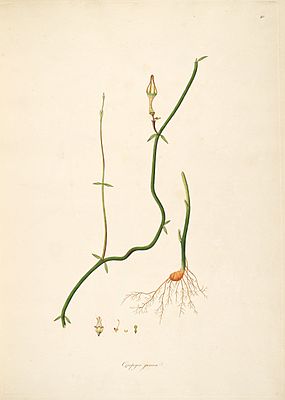Ceropegia juncea
| Ceropegia juncea | ||||||||||||
|---|---|---|---|---|---|---|---|---|---|---|---|---|

Ceropegia juncea (original illustration from Roxburgh, 1795, vol. 1, plate 10) |
||||||||||||
| Systematics | ||||||||||||
|
||||||||||||
| Scientific name | ||||||||||||
| Ceropegia juncea | ||||||||||||
| Roxb. |
Ceropegia juncea is a species of the subfamily of the silk plants (Asclepiadoideae).
features
Vegetative characteristics
Ceropegia juncea is a perennial , succulent , climbing, or twining plant with thickened or fibrous roots. The green, often red, finely striped shoots are up to 6 m long, with a diameter of 3 to 4 mm. The decrepit, slightly succulent leaves are sessile or short stalked, with the petioles up to max. 1 cm long. The leaf blades are elliptical and pointed to lanceolate. They are 4 to 10 mm long and 1 to 2 mm wide. The herbaceous shoots that form annually die completely at the end of the vegetation phase after the spindle-shaped fruits have burst down to the roots.
Inflorescence and flowers
The short-stalked inflorescence has few to many flowers . The flower stalks are 4 to 6 mm long, the sepals about 4 mm. The corolla has a length of 4 to 5.5 cm, is whitish green and red-brown speckled or overall brown-purple. The spherical to egg-shaped corolla tube kettle has a diameter of about 5 mm and merges continuously into the corolla tube. At the base (above the corolla tube) it initially has a diameter of 3 mm and widens towards the upper end in a funnel shape, with a diameter of up to 14 mm. Inside the tube there is plant hair at the base. The tips of the petals, which are hairy on the inside, are triangular in shape with a central keel, the tips are somewhat extended and narrowly linear. The two halves are completely turned outwards along the central axis. The tips unite over the opening of the corolla tube and form a triangular, cage-like structure when viewed from the side. The lower half of the petals are whitish, the upper half greenish or purple in color. The cup-shaped secondary crown is sessile. The interstaminal corolla lobes are oblong-egg-shaped and pointed towards the end. They are concave-pocket-shaped, ascending and incised at the top. They are 1.5 mm long and weakly ciliate. The staminal corolla lobes stand upright, are about 4 mm long and are linear-cylindrical in shape. The tips are curved inwards or outwards. On the outside they are more or less hairy at the base. The pollinia are egg-shaped.
Geographical distribution and ecology
The species occurs in India and Sri Lanka. The flowers are pollinated by small flies that are only about 3 mm in size.
Systematics and taxonomy
The species was first described scientifically in 1795 by William Roxburgh in his work "Plants of the Coast of Coromandel". The plants came from an unspecified location on the Coromandel Coast . Matthew (2004) specified the locality as the Northern Circars in what is now the Indian state of Andhra Pradesh . JF Hooker names the area Mumbai (formerly Bombay, in the state of Maharashtra ) and the Circars (state of Andhra Pradesh and Orissa ) to Thanjavur (formerly Tanjore, state of Tamil Nadu ) and Mysore (state of Karnataka ).
swell
literature
- Ulrich Meve: Ceropegia . In: Focke Albers, Ulrich Meve (Hrsg.): Succulents Lexicon Volume 3 Asclepiadaceae (silk plants) . Pp. 61-107, Eugen Ulmer Verlag, Stuttgart 2002, ISBN 3-8001-3982-0 (p. 83).
- Ken Harold: Two Indian Ceropegias. In: Asklepios , Volume 42, 1988, pp. 45-47.
Individual evidence
- ↑ S. Karuppusamy and T. Pullaiah: Pollination System and ex Situ Fruit Set in Ceropegia juncea Wight (Apocynaceae) - an Endemic Species of India. Academic Journal of Plant Sciences, 2 (4): 242-245, 2009 PDF
- ^ William Roxburgh: Plants of the Coast of Coromandel; Selected From Drawings and Descriptions presented to the Hon. Court of Directors of the East India Company. vol. 1, London, Bulmer, 1795 online at Botanicus.org (description of Ceropegia juncea on p. 12/3, plate 10).
- ↑ KM Matthew: William Roxburgh's plants of the Coast of Coromandel: an Enumeration of Species. Blumea, 49: 367-405, 2004 doi : 10.3767 / 000651904X484333
- ^ Joseph Dalton Hooker: Flora of British India, vol. 4, Asclepiadeae to Amarantaceae. London, Reeve 1885 online at Botanicus.org (description of Ceropegia juncea on p. 68)
Web links
- Ceropegia juncea on flowersofindia.in
- Ceropegia juncea on Ceropegia - all about Ceropegia ~ all about Ceropegia, website by Alexander Lang
- www.sciencephoto.com
(Many of the pictures of Ceropegia juncea that can be found on the Internet do not show the above species, but are incorrectly determined!)